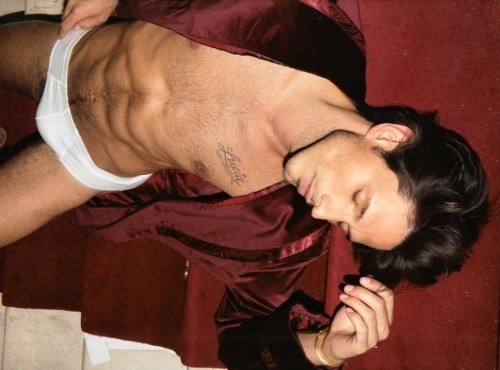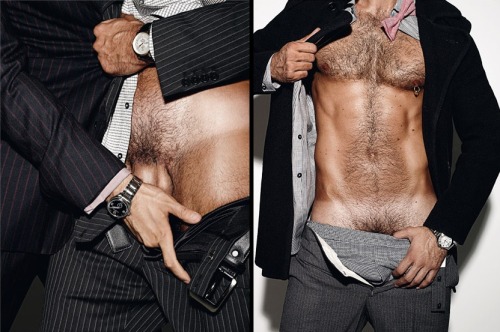
The new issue 1/2010 (aka, no. 19) of TUSH magazine features an interview with Homotography. I am a big fan of this German magazine and its continuous push for creative and cutting-edge photography, so I feel very honored and happy to have Homotography’s first ever interview in it. The interview was conducted by Claudia Seidel and appears in the magazine in German (see preview). Here is the English version.

We take blogging so much for granted – there’s a blog for anything and everything. Not all is good out there, but one blog really stands out from the rest: Homotography has been around for some time, with a constant stream of output true to its clearly defined topic – contemporary homoerotic photography in the fields of fashion, advertising and art. We asked the author for an interview. However, for reasons that will become clear in the article, we won’t be revealing his name.

TUSH: Why did you start with Homotography? Any personal or professional reasons?
Homotography is a personal adventure for me. I’d been thinking for a while about having a blog where I could bring together all my finds of photography with a homoerotic sensibility. Finally, a year ago, I decided the time was right. I didn’t have any particular expectations; I simply wanted to share photography that I found inspiring. From the name of the blog to the layout and content, Homotography is out and proud, and unabashed about celebrating photography with homosexual connotations. It has been a great ride since then. I am not a professional in the world of fashion or photography, but who knows, maybe Homotography will open a door on to something I feel passionate about as a career.

TUSH: When did you publish Your first post?
I published my first post on November 23, 2008, but I feel the blog’s identity only started to take shape at the beginning of 2009.

TUSH: Can you give us an idea of what’s involved, day by day, in collecting such a variety of contributions? Do photographers send images out of the blue or do you have to ask for images or editorials yourself?
It’s a combination of both, actually. As Homotography became more popular, photographers, magazine publishers and stylists started sending material to me to have their work featured. Also, when I come across an image or a photo shoot that intrigues me, I contact the artist and ask if they’d like to be featured in Homotography. I’m also very curious, and search engines are a blogger’s best friend. I often come across a reference to a photographer while reading an article, Google them to see their work, and end up discovering fantastic material in their portfolio.

TUSH: What criteria do you have for choosing whether to publish photos on your blog or not?
My main criterion is to ‘feel’ the images in order to feature the editorial or ad campaign. It is hard to define a formula for this; I just have to connect with the image. I feature both acclaimed photographers and new ones who have never been published. It’s all about the image for me. From a technical point of view, I aim for quality images and avoid poorly scanned ones or any that have logos or watermarks on them. I sometimes wait for months in order to get quality, clean images, before I feature a shoot. I think providing visually-attractive ‘eye candy’ is very important for a photography blog, and the readers appreciate the quality they get. Also, I believe that an important element in the success of any blog is applying a quality filter and avoiding ‘filler’ material.

TUSH: Do you receive a lot of comments, and if so, what issues or subjects are they mostly about?
Readers often don’t comment on the blog itself, but instead there’s a lot of interaction and feedback on the Homotography Facebook and Twitter pages. The comments are mostly feedback about specific editorials and posts, the photographer, the model, and the art direction. I have also gotten a few emails from readers and photographers explaining how Homotography helped inspire them and their future work and style of photography, which is the biggest compliment I could hope for.

TUSH: Since the blog started, have there been any changes in terms of your personal aesthetic preferences, your views on sexuality and the way it is presented, and the sort of comments you receive?
Oh yes, definitely. Having been exposed to more photographers, magazines and artists, I have widened my scope, and learned a huge amount. As for sexuality, I have sadly discovered throughout the past year that even though the fashion and photography world are well-known for being open-minded when it comes to sexuality, there is still a lot of homophobia in this business. I’ve had quite a few instances where photographers have asked me to remove images of a model or actor because they, or their agent, did not think it was good for their ‘image’ or career to be featured in such a blog. I took down one post, for example, when the featured model verbally threatened to attack a photographer with a knife because the photographer had shared the images with Homotography. The sad thing is that both the model and photographer are American, so I am not talking about an oppressed society like Iran or Saudi Arabia.

TUSH: Where do you live currently? And how do you get on with your homosexual identity, religious faith as well as your blogger identity there? Have you had, or might you have any difficulties, problems or even attacks?
I am currently living in Malaysia, but I am originally from Syria. Being an Arab and Muslim, my sexual identity and religious background are a constant source of conflict in my life in general. As far as my blogger identity is concerned, I have mostly kept it anonymous. It doesn’t affect the blog because readers come to Homotography to appreciate the images and art. The race or religion of the blogger does not (and indeed should not) affect their experience or view. On the other hand, keeping my blogging a secret is a difficulty that affects me in my personal life. Being passionate about the blog and the photography, it is hard, and emotionally painful sometimes, to hide that part in my social life. That is the main difficulty, not being able to do the blogging when I have friends or family around me, and not being able to share the excitement of having an interview with TUSH magazine with them.

Big thanks to Claudia Seidel and Armin Morbach at TUSH magazine for the interview. Also, a shout out to Predrag Pajdic for posting the interview in his fantastic blog, The Pandorian.